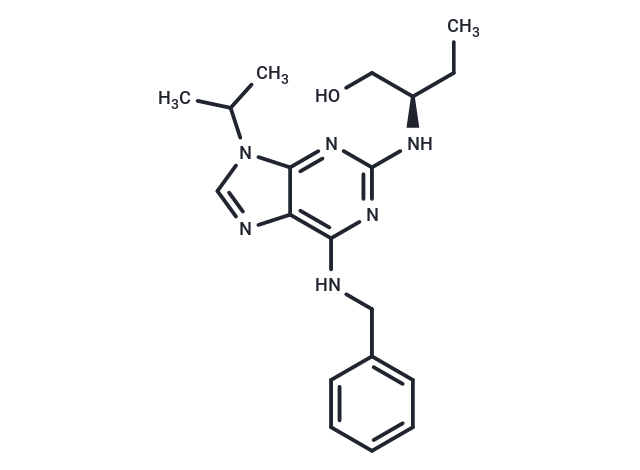购物车
- 全部删除
 您的购物车当前为空
您的购物车当前为空

Seliciclib (Roscovitine) 是一种 Cdk2/cyclin E 的有效抑制剂 (IC50=0.1 µM)。Seliciclib 还抑制 Cdk7/cyclin H、Cdk5/p35 和 Cdc2/cyclin B (IC50=0.49/0.16/0.65 µM)。Seliciclib 具有抗肿瘤活性。

Seliciclib (Roscovitine) 是一种 Cdk2/cyclin E 的有效抑制剂 (IC50=0.1 µM)。Seliciclib 还抑制 Cdk7/cyclin H、Cdk5/p35 和 Cdc2/cyclin B (IC50=0.49/0.16/0.65 µM)。Seliciclib 具有抗肿瘤活性。
| 规格 | 价格 | 库存 | 数量 |
|---|---|---|---|
| 5 mg | ¥ 415 | 现货 | |
| 10 mg | ¥ 734 | 现货 | |
| 25 mg | ¥ 995 | 现货 | |
| 50 mg | ¥ 1,597 | 现货 | |
| 100 mg | ¥ 2,433 | 现货 | |
| 200 mg | ¥ 3,996 | 现货 | |
| 1 mL x 10 mM (in DMSO) | ¥ 457 | 现货 |
| 产品描述 | Seliciclib (Roscovitine) is a potent inhibitor of Cdk2/cyclin E (IC50=0.1 µM). Seliciclib also inhibits Cdk7/cyclin H, Cdk5/p35 and Cdc2/cyclin B (IC50=0.49/0.16/0.65 µM). Seliciclib has antitumor activity. |
| 靶点活性 | CDK5-p35:0.16 μM (cell free), ERK2:14 μM (cell free), CDK2-CyclinE:0.7 μM (cell free), CDC2-cyclinB:0.65 μM (cell free), CDK2-CyclinA:0.7 μM (cell free) |
| 体外活性 | 方法: MM 细胞系 MM.1S、OPM2、RPMI、U266、Dox-40、LR5、MM1.R 用 Seliciclib (10-100 µM) 处理 24 h,通过 MTT assay 检测细胞活力。 结果: Seliciclib 在 24 h 内产生剂量依赖性细胞毒性,IC50 范围为 15-25 µM。[1] 方法: 套细胞淋巴瘤 (MCL) 细胞 Granta-519、NCEB-1、REC-1 和 JeKo-1 用 Seliciclib (25-50 µM) 处理 24-48 h,通过 Flow cytometry 检测细胞周期。 结果: 用 IC50 剂量的 Seliciclib 处理 24 h 后,Granta-519、NCEB-1 和 REC-1 细胞中检测到 G2-M 期细胞的积聚,与对照组相比,JeKo-1 细胞在 48 h 时检测到细胞的积聚。用 Seliciclib 处理 24 和 48 h 后,除 Granta-519 外,所有细胞的 sub-G1 峰都明显增加,表明细胞凋亡。[2] |
| 体内活性 | 方法: 为检测体内抗肿瘤活性,将 Seliciclib (300 mg/kg/d) 在 Zeitgeber 时间 (ZT) 3、11 或 19 口服给药给携带 Glasgow 骨肉瘤的 B6D2F1 小鼠,持续 5 天。 结果: 与对照组相比,Seliciclib 在 ZT3 或 ZT11 给药后将肿瘤生长减少了 55%,在 ZT19 给药后减少了 35%。[3] |
| 激酶实验 | Kinases activities were assayed at 30°C in buffer C (unless otherwise specified). Blank values were substracted from the data and activities calculated as the molar amount of phosphate incorporated in protein acceptor during a 10-min incubation. Controls were performed with appropriate dilutions of Me2SO. In a few cases, phosphorylation of the substrate was assessed by autoradiography after SDS/PAGE [1]. |
| 细胞实验 | L1210 cells taken from exponentially growing cultures in RPMT-1640 medium supplemented with 10% foetal calf serum, penicillin and streptomycin, were counted using a hemocytometer, seeded at 5X10^4 cells/ml in tissue-culture 96-wells plates in the presence or absence of various concentrations of roscovitine or olomoucine and incubated at 37°C under 5% CO,. For reversion of the roscovitine effect, L1210 cells cultured two days in the presence or absence of roscovitine were washed in phosphate-buffered saline to remove any trace of the drug, counted and reseeded in fresh medium containing no drug. Cell growth was monitored daily using the microculture tetrazolium assay. Cell cycle analysis was performed on cells that were fixed in ethanol, treated with 100 μg/ml RNase and stained with propidium iodide. We used a Coulter EPICS Elite flow cytometer for acquisition and the Multicycle software for analysis of the data. All assays were performed in triplicate and experiments repeated at least twice [1]. |
| 动物实验 | Male athymic nude mice (5-6 weeks old) were obtained from the National Cancer Institute. Mice were housed in the animal facilities of the Georgetown University Division of Comparative Medicine. All animal work was done under protocols approved by the Georgetown University Animal Care and Use Committee. Mice were inoculated s.c. into the right posterior flank with 4 × 10^6 A4573 cells in 100 μL of Matrigel basement membrane matrix. Xenografts were grown to a mean tumor volume of 129 ± 30 mm^3. Roscovitine was first dissolved in either absolute methanol or DMSO (1 volume). A carrier solution was produced by using a diluent containing 10% Tween 80, 20% N-N-dimethylacetamide, and 70% polyethylene glycol 400. Mice were randomized into two groups (six animals per group) and treatment was initiated. One group was treated with roscovitine, administered as a single daily i.p. injection, at a dose of 50 mg/kg, for either 5 days or two 5-day series with a 2-day break in between. The control group received i.p. injections of the carrier solution following identical schedules. All mice were sacrificed by asphyxiation with CO2. Roscovitine-treated mice were euthanized either 7 days after the first injection or up to 4 weeks after completion of the treatment. At those times, tumors were removed, measured, and prepared for TUNEL assays. Primary tumor volumes were calculated by the formula V = (1/2)a × b2, where a is the longest tumor axis and b is the shortest tumor axis. Data are given as mean values ± SE in quantitative experiments. Statistical analysis of differences between groups was done by a one-way ANOVA followed by an unpaired Student's t-test [4]. |
| 别名 | R-roscovitine, Roscovitine, CYC202 |
| 分子量 | 354.45 |
| 分子式 | C19H26N6O |
| CAS No. | 186692-46-6 |
| Smiles | CC[C@H](CO)Nc1nc(NCc2ccccc2)c2ncn(C(C)C)c2n1 |
| 密度 | 1.3 g/cm3 |
| 存储 | store at low temperature | Powder: -20°C for 3 years | In solvent: -80°C for 1 year | Shipping with blue ice. | ||||||||||||||||||||||||||||||||||||||||
| 溶解度信息 | H2O: < 1 mg/mL (insoluble or slightly soluble) DMSO: 50 mg/mL (141.06 mM), Sonication is recommended. Ethanol: 6 mg/mL (16.93 mM), Sonication is recommended. | ||||||||||||||||||||||||||||||||||||||||
溶液配制表 | |||||||||||||||||||||||||||||||||||||||||
Ethanol/DMSO
DMSO
| |||||||||||||||||||||||||||||||||||||||||
评论内容